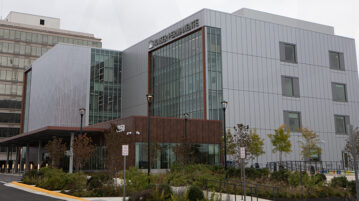By Leon Hwang, MD
Especially since the completion of the Human Genome Project in 2003, which identified the 20,000-plus genes in human DNA, medical researchers have a much greater and vastly more detailed understanding of the genetics and biology of cancers. Now scientists know many of the specific molecular and genetic changes that cause healthy cells to turn into different types of cancers. And they have figured out that the same kinds of cancer vary from one person to the next. For example, one woman’s stage 3c ductal breast cancer is not identical another woman’s stage 3c ductal breast cancer – and may not be treated exactly the same way.
New knowledge yields new treatments. Gone is the one-size-fits-most treatment protocol for a given type of cancer, and in its place is a new era of personalized cancer medicine. Today, doctors often can offer patients therapies that are much more tailored to each patient’s unique cancer biology. Not only have these new cancer treatments added years to patients’ lives and increased cure rates, they have done so with fewer of the side effects – nausea, fatigue, hair loss, to name a few – that accompany more traditional therapies.
Innovative healthcare providers are harnessing the power of these new treatments, as well as the latest technological advances, into a system of comprehensive cancer treatment. Read on to learn about a few of these new treatment options, as well as some newer types of clinical technology.
Targeted Drug Therapies
A hallmark of precision medicine, targeted drug therapies are drugs that aim to inhibit or shut down specific parts of cells, typically genes and proteins, that have an abnormality that was a factor in the start, spread, or growth of the cancer. Patients are matched to these therapies by being tested for the specific defect, often a gene mutation, that a given drug targets. These drugs often accompany other treatments such as chemotherapy.
One early such targeted drug that is enormously effective is trastuzumab , used to treat breast cancer patients who test positive for overproduction of a protein known as HER2. When added to the chemotherapy regimen, trastuzumab dramatically reduces the risk of recurrence of this aggressive form of the disease. Since it was approved, multiple such drugs have been introduced to the market for many types of cancer, with varying degrees of effectiveness. You can find a list of those drugs on the National Cancer Institute website.
Although targeted therapies are not without side effects, these side effects vary and are typically not as brutal as those inflicted by standard chemotherapy, which attacks healthy cells and tissue along with malignancies. Targeted therapies also reduce the amount of chemotherapy that patients need – and that alone makes patients more comfortable, improving quality of life and allowing many patients to spend time at home with family and friends instead of at the hospital.
Immunotherapy
Immunotherapy, which harnesses the body’s own immune system to fight cancer, is rapidly advancing treatment options for some kinds of cancer. In 2017, the Food and Drug Administration approved the first cancer therapy based solely on genetics and not the type of tissue or location of the cancer: the immunotherapy drug pembrolizumab . Because the immune system must be able to differentiate between self and non-self, it is particularly effective in cancers that have many mutations, such as in smoking-related cancers like lung and bladder cancer.
And just within the past year, axicabtagene ciloleuce and taisagenlecleucel – two forms of an immunotherapy treatment known as CAR-T therapy – made headlines when they were FDA-approved to treat certain types of leukemia and lymphoma that have resisted treatment and caused patients to relapse. CAR-T therapy involves drawing blood from the patient, extracting the T cells (white blood cells crucial to the immune system), re-engineering them so that they can recognize and kill cancer cells, and then injecting these cells back into the patient. The results have been stunning; more than half of patients who had only a small chance of survival have gone into complete remission lasting at least one year.
Radioimmunotherapy
Radioimmunotherapy combines radiation treatment and immunotherapy to fight cancer, especially cancers involving the bone, such as prostate cancer and lymphoma. It uses monoclonal antibodies – molecules produced in the lab and engineered to recognize and attach to the surface of cancer cells. These monoclonal antibodies are paired with a radioactive substance and injected into the patient’s bloodstream so that they can deliver a dose radiation directly to tumors to destroy them. Kaiser Permanente began offering this therapy last year.
Robotic Surgery
Robotic surgery, which allows surgeons to perform operations by controlling very small, precise robotic arms, has been a huge technological advance for treating some cancers. At MAPMG, physicians use this minimally invasive procedure to treat prostate cancers, for example. Removing the prostate is delicate surgery that carries risks such as urinary incontinence and sexual dysfunction. With robotic surgery, instead of making a large incision, the surgeon can make several small ones the size of a keyhole to remove the prostate. MAPMG oncologists also use robotic surgery to remove gynecological cancers such as those of the uterus, ovaries, and cervix. In all cases, the operation times are shorter, complications are fewer, and the recovery time is faster for patients, without compromising the outcome.
Interventional Radiology
Interventional radiology is a rapidly growing field that uses various types of imaging such as CT scans, MRIs, and X-rays to guide small instruments, such as catheters, through the body, allowing doctors to treat cancer non-surgically. For example, at MAPMG, radiologists perform a procedure in which they guide a thin antenna directly into a tumor through which microwaves are transmitted, which heat and destroy the tissue. This is called microwave ablation. Radiofrequency ablation uses high-frequency currents, instead of microwaves, to destroy smaller tumors.
These are especially good techniques for situations in which surgery is not good option. Because it is minimally invasive, side effects are few and can reduce the pain and recovery time for patients.
Those are just some of the new ways that physicians can treat cancer. And there’s even better news: Novel cancer treatments are developing so quickly that there will likely be newer therapies between the time this article appears and when you’ve finished reading it.
Learn more about MAPMG’s commitment to excellence in cancer care.





Discussion1 Comment
That is pretty awesome that people are living longer due to advancements in the treatment types. Seeing that there are different types of treatments, this does make sense that people are living longer since the treatments can be personalized. For me, I would go with immunotherapy as I think that would work best for me.